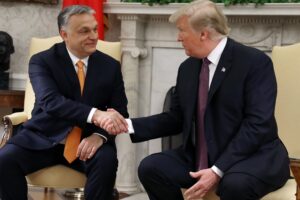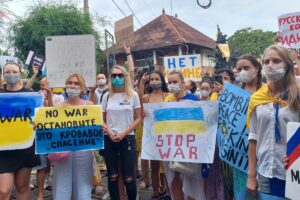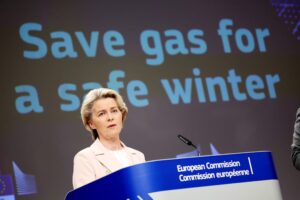The European Union (EU) and the Association of Southeast Asian Nations (ASEAN) formally marked almost half a century of diplomatic ties at the end of 2022. The two blocs’ forty-five-year commemorative summit was held in Brussels against a backdrop of Russia’s ongoing war in Ukraine and heightened security tensions in the Asia-Pacific given China’s continued and increasingly aggressive stance toward its southern neighbors and, in particular, in the Taiwan Strait.
Paradoxically, despite the intensified security situations in both regions and the extent to which the U.S.-China rivalry is squeezing the space for other actors to play a more strategic role in the Indo-Pacific, the security dossier has not featured heavily on the EU-ASEAN agenda. This is symptomatic not only of the way both organizations view each other’s respective capacities and interests in each region but also of the way the relationship has fared to date. There has been a series of highs and lows, with many of the more controversial issues—in particular, thorny democracy and human rights concerns—left to be either hammered out by diplomats or tackled by civil society, given sensitivities at the political level.
This misalignment on democracy will likely always be a point of contention, given each region’s inherent approach to this policy area: democracy is codified in the EU’s treaties, whereas ASEAN comprises a range of political systems. And while Europe has certainly managed to issue a coherent and comprehensive strategy on Asia, specifically the Indo-Pacific, and ASEAN has articulated its own Outlook on the Indo-Pacific, what these approaches should entail in practice and the motivations behind them remain nebulous because of the lack of an actionable and concrete forward vision.1
ASPECTS OF THE EU-ASEAN RELATIONSHIP
The main thrust of the EU-ASEAN relationship has focused very much on trade and investment, reflecting the EU’s competence vis-à-vis its member states and the areas where there is slightly more wiggle room for ASEAN as a whole. And despite the failure to advance an EU-ASEAN free-trade agreement (FTA), which has essentially been stalled since 2007, the EU has moved forward with bilateral FTAs with individual ASEAN member states—namely, Singapore and Vietnam—signaling at least the potential to fully realize the economic relationship.
There are both internal and external reasons for this prioritization of policy issues. For one, ASEAN as a regional organization is not set up in a similar way to the EU—it does not have a single currency or a customs union, for example—and nor does it have any ambition to be. ASEAN is more of a coordinating body and a clearinghouse for some of the region’s mutual concerns. It has no binding or enforcing power and operates on the basis of principled nonintervention in its member states’ affairs. That is something that a large majority of ASEAN nationals surveyed in late 2022 considered to be a serious handicap, resulting in the association being “slow and ineffective” at harmonizing regional responses.2 The EU, by contrast, acts as a much more integrated bloc, despite its internal disagreements and complex governance dynamics. For all intents and purposes, the EU—in its core areas of competence, especially trade—acts as any regional body looking out for the collective interests of its members would.
On the foreign policy side, however, both the EU and ASEAN face struggles. For one thing, the EU’s members have never entirely moved forward with relinquishing full control over external engagement to the union’s executive arm. This is why, despite the ratification of the EU’s Lisbon Treaty in 2009, the EU member states have continued to retain national competence over the many challenges that affect the union’s Common Foreign and Security Policy. ASEAN acts in a very similar way but much more strongly favors individual member states’ prerogatives. But there has never been any ambition or coordinated attempt to externalize ASEAN’s foreign policy engagement to the regional secretariat.
These discrepancies help explain why the EU-ASEAN relationship has been so stop-and-go over the past forty-five years. Yet, in the past decade or so, the geopolitical landscapes in Europe and Asia have changed significantly, leaving the EU and ASEAN exposed to critical security and economic vulnerabilities over which they have limited sway. This is especially true of the two organizations’ exposure to the U.S.-China rivalry, which, despite the Asia-Pacific being the main theater of this power play, has also affected Europe in many ways. Indeed, the United States’ prominent role in security dynamics in both regions—coupled with inescapable exposure to and engagement with China, which brings its own rapid growth, global ambitions, and increasingly polarizing worldview—has left the EU and ASEAN stuck in the middle of an extremely uncomfortable power rivalry.
The similarities in the ways in which the EU and ASEAN navigate between these two heavyweights are very much conditioned by the two blocs’ bilateral relationships with the United States and China. As regards the former, the EU has always prioritized strong transatlantic relations, despite interactions coming under strain in recent years. Indeed, with over 80 percent of EU countries allied with the United States through the North Atlantic Treaty Organization (NATO), it is difficult to imagine the EU collectively taking an all-out aggressive posture toward Washington, although there will inevitably be tensions among individual member states.3 ASEAN, meanwhile, features many countries that are not U.S. allies. Only two of the ten ASEAN members—the Philippines and Thailand—are formally allied with Washington through collective defense arrangements. Each ASEAN member state’s relationship with the United States falls on a different point along a spectrum, based on historical dynamics, economic and security dependencies, and values-based compatibilities.
When it comes to China, there is much congruity in the EU’s and ASEAN’s approaches. The EU’s current position toward China is to treat it as either a competitor, a rival, or a partner depending on the circumstances. ASEAN could be said to have deployed a very similar tactic—though that trichotomy is much more pronounced and dependent on individual nations’ relations with Beijing. Certainly, there is not yet a coordinated or formal mechanism that conditions a unified ASEAN response to China, given the organization’s stance on noninterference in member states’ affairs. That is a situation that China has undoubtedly been able to play to its advantage.
At the same time, there have been major differences in worldview between the EU and ASEAN. The most obvious recent example has been the contrast in responses to the war in Ukraine. The EU, for understandable reasons—including the fact that the conflict is playing out in the union’s immediate neighborhood—has taken a strong stance against Russia’s aggression in Ukraine and has expected its partners in the Global South to stand in solidarity with its position. This expectation is a values judgment based on the understanding that every nation is owed territorial sovereignty and that Russia’s unprovoked attack is fundamentally wrong.
The mixed reactions of the Global South to the war—and the perceived ambivalence of ASEAN members (with the exception of Singapore)—have led to incomprehension at best and an almost moral exasperation at worst from the EU. For their part, many ASEAN nations have been reluctant to take sides not because the territorial integrity of other sovereign nations is not sacred but because the interpretation of right and wrong is not so clearly black and white. Many ASEAN member states have observed decades of the West—especially the United States and, in some cases, specific EU member states—undertaking their own type of vigilante justice based on their interpretations of right and wrong in other parts of the world. ASEAN countries then ask how Russia’s unprovoked attack on Ukraine is different from, say, NATO’s 2011 intervention in Libya or even France’s 2014–2022 Operation Barkhane in the Sahel.
TOWARD NEW FORMS OF COLLABORATION?
Given this kaleidoscope of variables, a core purpose of this publication is to ask what space there is for Europe and Asia to forge different forms of collaboration and reimagine what the partnership could look like in areas of common interest. This compendium is unique in two ways: First, it examines the relationship at face value. The point is to remove, to the extent possible, the United States and China as variables from the relationship and explore ways for creative collaboration. Second, each chapter is co-written by an Asian and a European analyst in equal partnership, reflecting the project’s approach of bringing together two views on each issue with equal merit.
Each chapter provides the state of play of the EU-ASEAN relationship on a specific issue, takes a deep dive into the challenges on the horizon, and offers opportunities for moving the relationship forward. What emerges is a picture of a relationship that is as dynamic as it is complex. This speaks volumes of the need to approach policy issues from a multisector, multistakeholder perspective that does not silo individual issues but treats them as inherently dependent on other policy areas.
The climate chapter highlights the challenges of reconciling climate targets and global commitments with realities on the ground, especially in light of the EU’s green energy policies like the renewable energy directive, the Carbon Border Adjustment Mechanism, and Just Energy Transition Partnerships. In the security chapter, the authors outline the difficulties of the EU and ASEAN seeing eye to eye not only because of differing interpretations of what security means in each region but also because of the fundamental approach each actor has taken toward this policy area since the outset.
The technology chapter provides much more fertile ground for advancing the EU-ASEAN agenda because of the way other Asian actors in the Pacific have harnessed the EU’s regulatory standards for their own national models and because there is a genuine recognition that there are mutual lessons to be learned. Unsurprisingly, the trade chapter focuses on what could be called the hallmark of the relationship. The EU increasingly sees ASEAN as an alternative partner that can help the union boost its supply-chain resilience, while ASEAN sees the potential to harness EU investment in the region. But vying national interests and differing economic capacities on both sides also play out in the relationship.
The chapter on democracy—possibly the most contentious issue, and not just because of a long track record of misalignment—reveals perhaps the area of most raw but palpable potential. There is surprisingly much the EU can learn from the Asian models of democracy because space for civil society has been so stifled. Civil society actors in many ASEAN states have become much nimbler and more creative than the EU, where civil society is more mature and society is increasingly polarized.
Together, the chapters paint a vivid picture of the possible areas for the EU and ASEAN to work together and create a space that is very much their own, despite the challenges. Hubris needs to be dealt with on both sides. The EU’s perceived righteous indignation in the face of ASEAN states’ desire to create their own path separate from the Global North needs to be met with the full recognition that this relationship can realize its potential to do more in the coming years. The EU and ASEAN have a mutual need for each other’s presence in international affairs—and for a relationship based on true cooperation and the realization of concrete outcomes.
Source: Carnegie Europe















